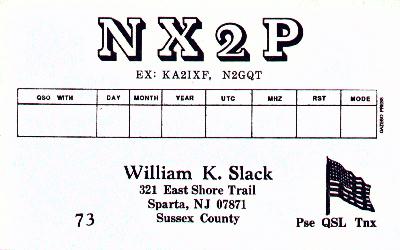 My Antennas
My Antennas
 My Antennas
My Antennas
Currently all my antennas are on my tower. I had some wire antennas, but they got all pulled down when I was clearing out some trees last fall. I need to get those back up. So, what's up there? From bottom (just above the rotor at approximatly 60ft) to the top, it "stacks" up as follows:
The combination of the mast and the Hustler G7 give a total of 33ft build above to rotor. This brings the total height to 90+ feet.
My tower used to be 75ft, but I lost 15ft when it fell down back in 1989 in a very heavy wind storm. I cut away the broken sections and put what remained up while adding a bigger and better antenna system. My policy is that if one of my antennas falls down it is not a loss, but an opportunity to put up a larger one. This configuration has not fallen down yet even though we have had several very nasty storms. I may just have to put up a bigger one anyway.
 My Location (view to the northeast)
My Location (view to the northeast)
My location is not particularly good for radio. I am located in a valley at approximatly 780ft MSL elevation. Each side of the valley there are ridges going up to 1100ft. This creates a significant limitation on my VHF/UHF work. My house is on one of the slopes so my view to the southeast is blocked badly. To the west it is not so bad as I have a clear shot about a mile to the far ridgeline which gives me a chance of getting over. The good news is that I am about 150ft above the surface of the lake that fills the valley floor. The valley is closed at the southwest, but is open towards the north and northeast. Ground conductivity is relitivly good and the sloping ground seems to give me a good low takeoff angle on HF. I can put a killer signal into europe on the low bands. In fact, except due south and southeast, I don't have a particularly bad HF location.
One of my favorite low band activities is to drop to the very bottom of 15M or 20M CW and turn the yagi to the west or northwest and see if I can get something out in the pacific. Usually I get a very weak response from a CQ and usually it turns out to be europe off the side of the yagi. After I turn the beam, towards europe I can work one station after another. Usually they are eastern europeans running QRP who in responding to my strong signal are hoping I will hear them. Often I have to dig them out of the noise and consequently I put a premium on a good reciever.
 My Original QSL
My Original QSL
I got my novice license a month before field day in 1980. I was just 15 years old. Field day really built my CW skills as I made most of the contacts the local club made from their novice station that year. Unfortunatly there was a problem with the rigs used in the novice station and at times there was no available radio. During some of these periods I logged at the 40M CW station. I was suprised that after some time I was starting to copy some of that fast CW. My code speed must have gone from 8WPM to 10WPM to15WPM (at least in short bursts) that night.
I passed my general exam December 31st 1980 in the FCC office in New York City. I kept the KA2IXF callsign at this time. As I had a CW only rig, I continued operating exclusivly in this mode. As luck would have it, KA2IXF turns out to be a fairly good CW callsign although a bit long. In 1987 shortly after having my license renewed, I decided to change my callsign. I thought I would get a shorter call. Unfortunatly I got the call N2GQT which was terrible in both voice and CW.
Shortly thereafter I went to a VE session to try for an upgrade. The near exclusive CW operation when I was more active on HF paid off and I passed my 20WPM code test even though I had only practiced CW for an hour after not having been active for a couple of years. I had not expected to pass and had not reviewed the Extra class exam. As it turned out, I passed the advanced exam without problem, but missed the Extra theory by one question. I took the exam again two weeks later at another VE session and got the Extra class license. This is when I put in for the callsign change. I was happy to get the NX2P callsign and had only had the N2GQT callsign for a couple of months. I don't believe I ever got QSL cards for the N2GQT call. On the other hand I have went through one order and am on the middle of my second order of NX2P QSL cards.
 My First NX2P QSL
My First NX2P QSL
 My Current NX2P QSL
My Current NX2P QSL
Packet Radio
[work in progress]
NETMGR - This is a program that I wrote to help manage ROSE networks. It provides a graphical interface and can automatically generate the routing tables.
Organizations
Copyright (C) 1997 William K. Slack